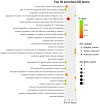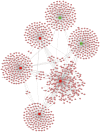Identification and functional analysis of microRNAs in rats following focal cerebral ischemia injury
- PMID: 30896823
- PMCID: PMC6471137
- DOI: 10.3892/mmr.2019.10073
Identification and functional analysis of microRNAs in rats following focal cerebral ischemia injury
Abstract
MicroRNA sequencing (miRNA‑seq) was performed in the present study to investigate miRNA expression profiles in infarcted brain areas following focal cerebral ischemia induced by middle cerebral artery occlusion in rats. In total, 20 miRNAs were identified to be upregulated and 17 to be downregulated in the infarct area. The expression levels of six differentially expressed miRNAs (DEmiRs), miR‑211‑5p, miR‑183‑5p, miR‑10b‑3p, miR‑182, miR‑217‑5p and miR‑96‑5p, were examined by reverse transcription‑quantitative polymerase chain reaction. Subsequently, a miRNA‑mRNA network was constructed. Gene Ontology and Kyoto Encyclopedia of Genes and Genomes analyses were performed to investigate the functions of the mRNAs targeted by these DEmiRs. The present study aimed to investigate the association between miRNAs and cerebral ischemia to provide potential insight into the molecular mechanisms underlying ischemic stroke.
Figures








Similar articles
-
Biliverdin administration regulates the microRNA-mRNA expressional network associated with neuroprotection in cerebral ischemia reperfusion injury in rats.Int J Mol Med. 2019 Mar;43(3):1356-1372. doi: 10.3892/ijmm.2019.4064. Epub 2019 Jan 14. Int J Mol Med. 2019. PMID: 30664169 Free PMC article.
-
Identification and Functional Analysis of MicroRNAs in Mice following Focal Cerebral Ischemia Injury.Int J Mol Sci. 2015 Oct 14;16(10):24302-18. doi: 10.3390/ijms161024302. Int J Mol Sci. 2015. PMID: 26473853 Free PMC article.
-
Co-Expression Network Analysis Identifies miRNA⁻mRNA Networks Potentially Regulating Milk Traits and Blood Metabolites.Int J Mol Sci. 2018 Aug 24;19(9):2500. doi: 10.3390/ijms19092500. Int J Mol Sci. 2018. PMID: 30149509 Free PMC article.
-
microRNAs: innovative targets for cerebral ischemia and stroke.Curr Drug Targets. 2013 Jan 1;14(1):90-101. doi: 10.2174/138945013804806424. Curr Drug Targets. 2013. PMID: 23170800 Free PMC article. Review.
-
Neuroprotective Effects of Peptides in the Brain: Transcriptome Approach.Biochemistry (Mosc). 2020 Mar;85(3):279-287. doi: 10.1134/S0006297920030037. Biochemistry (Mosc). 2020. PMID: 32564732 Review.
Cited by
-
Emerging Impact of Non-coding RNAs in the Pathology of Stroke.Front Aging Neurosci. 2021 Nov 19;13:780489. doi: 10.3389/fnagi.2021.780489. eCollection 2021. Front Aging Neurosci. 2021. PMID: 34867304 Free PMC article. Review.
-
Hearing impairment due to Mir183/96/182 mutations suggests both loss and gain of function effects.Dis Model Mech. 2020 Dec 14;14(2):dmm047225. doi: 10.1242/dmm.047225. Online ahead of print. Dis Model Mech. 2020. PMID: 33318051 Free PMC article.
-
Alterations in apoptotic pathways and expression of miR-134, miR-181, and miR-497 induced by Wharton's jelly-derived mesenchymal stem cells in a rat model of ischemic brain injury.IBRO Neurosci Rep. 2025 Apr 28;18:759-770. doi: 10.1016/j.ibneur.2025.04.015. eCollection 2025 Jun. IBRO Neurosci Rep. 2025. PMID: 40502966 Free PMC article.
-
LncRNA GAS5 Silencing Attenuates Oxygen-Glucose Deprivation/Reperfusion-Induced Injury in Brain Microvascular Endothelial Cells via miR-34b-3p-Dependent Regulation of EPHA4.Neuropsychiatr Dis Treat. 2021 May 26;17:1667-1678. doi: 10.2147/NDT.S302314. eCollection 2021. Neuropsychiatr Dis Treat. 2021. PMID: 34079264 Free PMC article.
-
CircRNA CTNNB1 (circCTNNB1) ameliorates cerebral ischemia/reperfusion injury by sponging miR-96-5p to up-regulate scavenger receptor class B type 1 (SRB1) expression.Bioengineered. 2022 Apr;13(4):10258-10273. doi: 10.1080/21655979.2022.2061304. Bioengineered. 2022. PMID: 35435123 Free PMC article.

